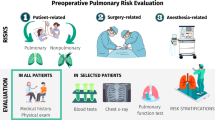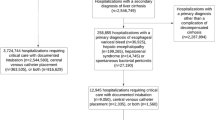Abstract
Background
Postoperative respiratory failure (PRF) is associated with increased morbidity after surgery. This retrospective study explores preoperative and perioperative risk factors associated with PRF in patients undergoing cytoreductive surgery and hyperthermic intraperitoneal chemotherapy (CRS/HIPEC) and the resultant impact on survival.
Methods
We identified all patients who underwent CRS/HIPEC at our institution between 2007 and 2017. PRF was defined as mechanical ventilation for more than 48 h after surgery or reintubation not related to an additional procedure within the first 30 days postoperatively. The relationship between clinicopathologic variables and PRF was examined using Kaplan–Meier log-rank survival analysis and multivariable Cox regression models with 90-day, 1-year and 5-year overall survival (OS).
Results
Overall, 314 patients underwent CRS/HIPEC, of whom 24 patients (7.6%) developed PRF. On univariable analysis, chronic obstructive pulmonary disease (COPD) was the only preoperative risk factor associated with PRF (p = 0.049). Of the intraoperative risk factors, diaphragmatic resection (p = 0.008), Peritoneal Cancer Index (PCI) > 20 (p < 0.001), and volume of intraoperative crystalloid (p < 0.001) were all associated with PRF. On multivariable Cox regression, only intraoperative crystalloid was significantly associated with PRF (p < 0.001), with a volume above 5.3 L (area under the curve [AUC] 0.77) having a high predictive accuracy for PRF. Five-year OS was significantly decreased in patients with PRF (30.2% vs. 52.6%, hazard ratio 2.6, 95% confidence interval 1.5–4.4; p < 0.001).
Conclusions
Liberal intraoperative crystalloid volume resuscitation is a potential independent, modifiable intraoperative risk factor for PRF following CRS/HIPEC that may contribute to decreased long-term OS.


Similar content being viewed by others
References
Foster JM, Sleightholm R, Patel A, et al. Morbidity and mortality rates following cytoreductive surgery combined with hyperthermic intraperitoneal chemotherapy compared with other high-risk surgical oncology procedures. JAMA Netw Open. 2019;2(1):e186847.
Leigh NL, Solomon D, Feingold D, Magge DR, Golas BJ, Sarpel U, Labow DM. Improved survival with experience: a 10-year learning curve in hyperthermic intraperitoneal chemotherapy and cytoreductive surgery. Ann Surg Oncol. 2020;27(1):222–31.
Schneider MA, Eshmuminov D, Lehmann K. Major postoperative complications are a risk factor for impaired survival after CRS/HIPEC. Ann Surg Oncol. 2017;24:2224–32.
Simkens G, Oudheusden T, Luyer M, et al. Serious postoperative complications affect early recurrence after cytoreductive surgery and HIPEC for colorectal peritoneal carcinomatosis. Ann Surg Oncol. 2015;22:2656–62.
Marcel André Schneider. Major postoperative complications are a risk factor for impaired survival after CRS/HIPEC. Ann Surg Oncol. 2017;24(8):2224–32.
Colantonio L, Claroni C, Fabrizi L, et al. A randomized trial of goal directed vs standard fluid therapy in cytoreductive surgery with hyperthermic intraperitoneal chemotherapy. J Gastrointest Surg. 2015;19:722–9.
Eng OS, Dumitra S, O’Leary M, et al. Association of fluid administration with morbidity in cytoreductive surgery with hyperthermic intraperitoneal chemotherapy. JAMA Surg. 2017;152(12):1156–60.
Rollins KE, Lobo DN. Intraoperative goal-directed fluid therapy in elective major abdominal surgery: a meta-analysis of randomized controlled trials. Ann Surg. 2016;263(3):465–76.
Dushianthan A, Knight M, Russell P, Grocott MP. Goal-directed haemodynamic therapy (GDHT) in surgical patients: systematic review and meta-analysis of the impact of GDHT on post-operative pulmonary complications. Perioper Med (Lond). 2020;9:30.
Brandstrup B, Tønnesen H, Beier-Holgersen R, et al. Effects of intravenous fluid restriction on postoperative complications: comparison of two perioperative fluid regimens: a randomized assessor-blinded multicenter trial. Ann Surg. 2003;238(5):641–8.
Fernandez-Bustamante A, Frendl G, Sprung J, Kor DJ, Subramaniam B, Martinez Ruiz R, et al. Postoperative pulmonary complications, early mortality, and hospital stay following noncardiothoracic surgery: a multicenter study by the perioperative research network investigators. JAMA Surg. 2017;152(2):157–66.
Yang CK, Teng A, Lee DY, Rose K. Pulmonary complications after major abdominal surgery: National Surgical Quality Improvement Program analysis. J Surg Res. 2015;198(2):441–9.
Preti V, Chang D, Sugarbaker PH. Pulmonary complications following cytoreductive surgery and perioperative chemotherapy in 147 consecutive patients. Gastroenterol Res Pract. 2012;2012:635314.
Chen MYM, Chiles C, Loggie BW, Choplin RH, Perini MA, Fleming RA. Thoracic complications in patients undergoing intraperitoneal heated chemotherapy with mitomycin following cytoreductive surgery. J Surg Oncol. 1997;66(1):19–23.
Dagbert F, Thievenaz R, Decullier E, et al. Splenectomy increases postoperative complications following cytoreductive surgery and hyperthermic intraperitoneal chemotherapy. Ann Surg Oncol. 2016;23:1980–5.
Franssen B, Tabrizian P, Weinberg A, Romanoff A, Tuvin D, Labow D, et al. Outcome of cytoreductive surgery and hyperthermic intraperitoneal chemotherapy on patients with diaphragmatic involvement. Ann Surg Oncol. 2015;22(5):1639–44.
Berdah SV, Picaud R, Jammes Y. Surface diaphragmatic electromyogram changes after laparotomy. Clin Physiol Funct Imaging. 2002;22(2):157–60.
Clavien PA, Barkun J, de Oliveira ML, et al. The Clavien-Dindo classification of surgical complications. Ann Surg. 2009;250(2):187–96.
Lopes JA, Jorge S. The RIFLE and AKIN classifications for Acute Kidney Injury: a critical and comprehensive review. Clin Kidney J. 2013;6(1):8–14.
Tabrizian P, Shrager B, Jibara G, et al. Cytoreductive surgery and hyperthermic intraperitoneal chemotherapy for peritoneal carcinomatosis: outcomes from a single tertiary institution. J Gastrointest Surg. 2014;18:1024–31.
Jacquet P, Sugarbaker PH. Clinical research methodologies in diagnosis and staging of patients with peritoneal carcinomatosis. In: PH Sugarbaker, editor. Peritoneal carcinomatosis: principles of management. Boston: Kluwer; 1996. p. 359–74.
Hendrix RJ, Damle A, Williams C, et al. Restrictive intraoperative fluid therapy is associated with decreased morbidity and length of stay following hyperthermic intraperitoneal chemoperfusion. Ann Surg Oncol. 2019;26:490–6.
National Surgical Quality Improvement Program. Chicago, IL: American College of Surgeons; 200.
Xing XZ. Risk factors and prognosis of critically ill cancer patients with postoperative acute respiratory insufficiency. World J Emerg Med. 2013;4(1):43.
Khuri SF, Henderson WG, DePalma RG, et al. Determinants of long-term survival after major surgery and the adverse effect of postoperative complications. Ann Surg. 2005;242:323–6.
Sullivan BJ, Bekhor EY, Carpiniello M, Leigh NL, Pletcher ER, Solomon D, et al. Diaphragmatic peritoneal stripping versus full-thickness resection in CRS/HIPEC: is there a difference? Ann Surg Oncol. 2020;27(1):250–8.
Cascales Campos P, Martinez Insfran LA, Wallace D, Gil J, Gil E, Gonzalez Gil A, et al. Identifying the incidence of respiratory complications following diaphragmatic cytoreduction and hyperthermic intraoperative intraperitoneal chemotherapy. Clin Transl Oncol. 2020;22(6):852–9.
Shin CH, Long DR, McLean D, et al. Effects of intraoperative fluid management on postoperative outcomes: a hospital registry study. Ann Surg. 2018;267:1084–92.
Sugarbaker P. Cytoreductive surgery using peritonectomy and visceral resections for peritoneal surface malignancy. Transl Gastrointest Cancer. 2013;2(2):54.
Author information
Authors and Affiliations
Corresponding author
Ethics declarations
Disclosures
Eric Pletcher, Da Eun Cha, Elizabeth Gleeson, Tali Shaltiel, Deepa Magge, Noah Cohen, Umut Sarpel, Daniel Labow, and Benjamin Golas do not have any disclosures to declare.
Additional information
Publisher's Note
Springer Nature remains neutral with regard to jurisdictional claims in published maps and institutional affiliations.
Rights and permissions
About this article
Cite this article
Pletcher, E., Cha, D.E., Gleeson, E. et al. Postoperative Respiratory Failure Following Cytoreductive Surgery and Hyperthermic Intraperitoneal Chemotherapy is Associated with Volume of Intraoperative Crystalloid Administration and Worse Survival. Ann Surg Oncol 30, 437–444 (2023). https://doi.org/10.1245/s10434-022-12199-4
Received:
Accepted:
Published:
Issue Date:
DOI: https://doi.org/10.1245/s10434-022-12199-4




